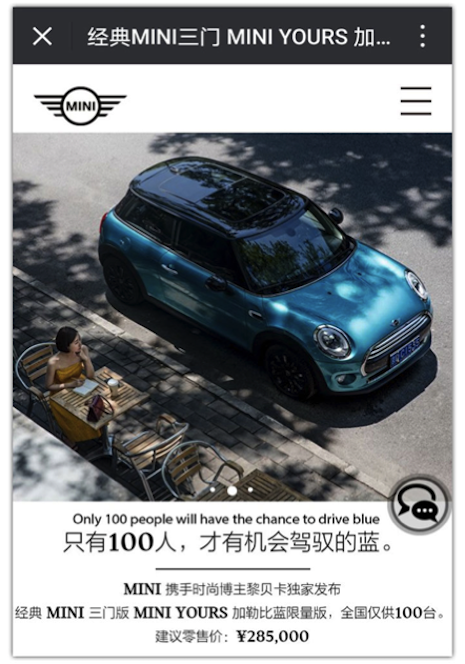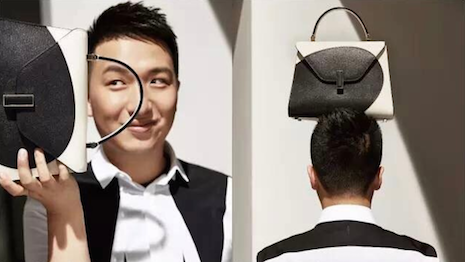China’s key opinion leaders are causing influencer marketing to evolve from content publishing to drivers of ecommerce sales, according to new findings from The Luxury Conversation.
KOLs such as Mr. Bags and Gogoboi have massive social media followings with global reach, and their communities are responding to sponsored posts and brand collaborations through ecommerce. In China especially, the Luxury Conversation has noted in its “KOLs in China -- From Publishers to Ecommerce” report that this trend is exploding with influencers helping brands to sell products directly rather than a simple branded content post.
"First, China has the largest online population in the world," said Nick Cakebread, managing partner at Shanghai-based Reuter Communications, who commissions The Luxury Conversation. "This allows KOLs in China to reach an audience of millions very quickly.
"Second, there are two dominant social media networks in China: Weibo and WeChat," he said. "The latter is involved in so many aspects of a person's life in China. These two ecosystems means less fragmentation."
"Third, many Chinese are hungry for information, knowledge, product information and new brands. The middle class is emerging and developing therefore they are aspirational and looking to KOLs as a source of inspiration, content, news and education."
Power to the KOLs
In its report, the Luxury Conversation examined four recent examples of the influencer-to-sales shift to emphasis Chinese KOLs’ selling power.
The first examples concentrated on Mr. Bags, one of China’s top 10 influencers. Mr. Bags counts more than 3 million followers on Weibo and his WeChat posts average more than 100,000 views.
Given his focus on fashion accessories, namely handbags, Mr. Bags has paired with a number of leather goods brands and fashion houses to promote products within the category.
Around Valentine’s Day earlier this year, Mr. Bags partnered with French fashion house Givenchy. The influencer worked with Givenchy to promote a Valentine’s Day x Mr. Bags limited-edition mini Horizon handbag in light pink.
Givenchy’s 80 Valentine’s Day x Mr. Bags handbags were priced at RMB 14,900 each, or $2,235 at current exchange. Per the Luxury Conversation, the 80 handbags sold out within 12 minutes from when Mr. Bags’ post went live.
In a similar collaboration Mr. Bags worked with Italian leather goods maker Tod’s to customize three of the brand’s iconic handbags, the Sella, Double T and Wave.
For the campaign, Mr. Bags encouraged his followers to be involved in the design of the capsule collection. This was achieved through live streaming, video content and imagery that allowed for follower feedback and generated hype for the launch.
The 200 customized handbags sold out for a total value of RMB 3.4 million, or $510,000.
Similarly, Gogoboi, another top 10 fashion influencer in China, has evolved his personal brand from content creation to an ecommerce vehicle.
Gogoboi has more than 7 million Weibo followers and discusses trends on his “Who Wears What?” feature on WeChat. In May, Gogoboi launched a WeChat ecommerce channel that links all recommendations to direct sales.
Working with Givenchy, Gogoboi recently paired with the brand to sell the newly introduced Duetto handbag collection. Gogoboi worked with Givenchy to allow his followers to purchase one of six handbags available in seven colors.
In just 72 hours, all Duetto handbags were purchased.

Gogoboi's product recommendations are linked to ecommerce. Image credit: The Luxury Conversation
Although the price tag for a high-end handbag is relatively affordable in the grand scheme of things, Chinese KOLs have been proven to sway even big-ticketed purchases.
For example, Becky Li, dubbed the “Buying Goddess” due to her product recommendations and more than 1.6 million WeChat followers, successfully sold BMW-owned Mini Coopers to her fan base.
In late July, Becky Li launched the “Mini Yours” campaign with the automaker. In her posts, Becky Li posted content about the Caribbean Aqua color, matching the blue to various fashion recommendations.

Becky Li worked with Mini Cooper to sell a limited-edition model. Image credit: The Luxury Conversation
The 100 limited-edition Mini Coopers in Caribbean Aqua sold out within four minutes of launch with an asking retail price of RBN 285,000 or $42,760.
"Working with different KOLs will sometimes achieve different objectives," Reuter Communications' Mr. Cakebread said. "Some have a huge reach and will help drive top of mind awareness.
"Otherwise have smaller fan bases but their followers are very loyal and highly engaged," he said. "This means that the content they post of the products they recommend are frequently snapped up.
"It is important to understand a brand’s objectives for working with KOLs at the start to shape the campaign."
Tips for success
KOLs in China are extremely effective at marketing high-end products. So much so, that L2 found that influencer posts are eight times more popular than brand posts in China (see story).
The Luxury Conversation suggests too that KOLs be used by luxury brands as not only an awareness-building tool but as a channel to launch and sell exclusive products.
To do so, the Luxury Conversation offers three tips for success:
Ensure that KOL and brand collaborations are authentic and meaningful. If a product collaboration is off brand, consumers are less likely to engage.
Secondly, the Luxury Conversation stresses bring followers into the process. Consumers appreciate being brought into the fold, and want to be asked by their favorite KOL for feedback. A one-sided effort will not result in the desired effect.
Lastly, brands should work to establish long-term relationships with KOLs. By having a relationship the KOL-backed collaboration reads as a natural extension between the influencer, brand and followers.
"It’s very important to choose the right KOL that fits the brand and can deliver the objectives outlined," Reuter Communications' Mr. Cakebread said.
"This means researching the brands the KOL has worked with in the past, what kind of collaborations the KOL has done, what kinds of posts and content he/she creates, the reach and engagement of the posts, the style of the content," he said.
"There are no shortages of KOLs in China so make sure you do your research to understand the landscape and which one you want to work with."
{"ct":"LjzIAnbsys\/ICDDpB+kXfnqZrkfN5NRTu94MtZzCgBNBmy7Fml9ONswOw42n3\/CL9M97Z5rg3SZxrMBhovSRjO7+pE9j\/U11lXEV6rq11YjY481mv9iOdsB9E1StEjLY6sCphFSqfsmjZlbolnlltK8OrDQZrNH5cEe1zfGun\/6XGgoSVKRYzxcIHgPWaejL\/pr71RiGPEYCl2Mh5nS0NDBmVw6DNUgeUJP2IUey7KarBLE8Osre40GJOxD\/eS1ezb1l9v9agNj\/Uvt9KzVaFsur4bPftE3Gwl8lpNOfoMVAKf6S6Eqcflleixl8slmAZ9JFoqkjc3L+ry0TiUH6mKRsgz1i9CfsgZ5bv3X\/74nPQ\/0wnXOLUTKzy8E\/0Gi\/ZCapVn9MSpcFacAbnwSjRRMU+rtplYgXcR0VUgVnMwa54Vq\/EK3MVlUrE389NX\/GLonA7Ho7MofiAeT7g1vxt4LVODp8agznRkDtlhxM1IfC+Uc0vJkTYuXVk75pocUGttvSTO0jkvBisETOuHOZtjdMusd91F1EtNxSCvK188gWGvsCnmzpgU9cuYhoahtVBpXViSkv43KTFWJ51LjsPOy1OAYLQMS70qhKxGK8IuSJuhnISAQp2PbC9cd46x232wcEU6FhVYd1vL3bQ+GB2EYufieAmKp6S1F7OlKSv2dGNgPSiKqI4VwQfIF7Mvc7pk9S8yNplhpY+g9wzdmVoWC3yeDmzMRV9Sz9Uk6RqF\/NbtAEKtlo8xoDrbKsy4WDMZ1bTgTFc8uo73Li6TCUcn2kMSuO10oO3pfSNyKEvAgfjkSUSWyUQXCiMHTqGphe3Bs\/4rXOLQPL4bhQg\/6Ug5Fq8TI54VBEw0DW5MnrPYZrsCDJu4JVXFLEWYKqrtGthx3gHUWFN8QLFUx7QczVs2lrqPeMvLRFvEaZyk0WqxSEq+qlMJLjLmU1wFD+6BbcxXAidteRlTVifkI21\/QNRsLLTYwwxnKEkUhmxnbX3UE5vjHOLEA1QHf2DCt4ITVszENjkyyxxf2xLpuMwVcC7uWxoYmRjTGfdO1aTg9p+WL+x\/Dh0V\/JAjY8hl61xzu7v7+wUO389gSdf\/AHTtHO3ilrkcB4GferTNdGKFpjzOjWL0J5S9RVAS6FnwMSbEJRd3frTV1cksmJ3djtb14St+ethBAA+vx2eTSyfkG5J1z3tegz83HbYGjozImB+2Z+W7gl2P+tvi8ah497g\/dhS3JnQh\/y4F4zSTP7bzvvpK8ux2ohtZWLrLl7wSclZLcbb7dZRSAmwrzZuQl+xEyiFZQvqBeix\/dmk1EMUXpZCUh9SUh+Ncd0CiLlBFauyJV6GqR4UneyTxwq7t4AWt\/0MWcNVix79EqL6yzjleIKFpmU+yMKgKhKadJ44rWu\/\/zLMm1ZCOKAqsOcoSv2PvGHvIPEe6n+tm3y\/QSbSdhep\/VskPL3LDKhcfTi3Z24aZ8cbBI8pZV5kuhRSrtNxlUdmegSCpJLcRZ4Hujd3Kdi2cj6JjPe4yduvebJOnPeIKNoui+2YbFwX4zelxz2Sb0CN1Guq9xXZRorvl5IhtS3p9V9dCf\/MRDYYYr9hbCZROusnaV\/CgfLXiRYOwD1t+FR+AmExkAlkY8TEZI7OlpMZxccV+lmHr1FtgydVWJnNgacGol7Z7sWwBpqnA0sJLl0y5V6QOJNWWesrWOU5GndgTEQoystCu\/q7EQHR3DEZIk9Jbn6pumW0bqFqV9Df\/ubmbX08JX8bYXFWgbA1SqEK7eFZbn4EJIK5VroXlYbjQgGra\/Qx5sdklPRa218TiE\/4Fd9bhTq+1GkrJwbCHRfuHIl43qw8gBFh8tyoMZkjAtZOfdC\/71w0QkfB8TgCsTA6LG8Fh7bg7K8WuaDmdzDQ0gDgDGIfqQ2zWwDPSlic6XyJeZKz4DvARE8M8BvBEg+Jj7chAMtdbHbLR+jGFQT4avv\/QPbJZhZHhu5LIyBl2MpTYWmPeP8u8DiWlMwyZePWjrNn80RRHuvv\/iJLMEBmz7kCL7MkNC4eUq\/mxitATggTZeSuP5o2ulJwt5s6UdYr3SioD6\/xW0QKZd3snI+TVMzm88XIfvyLvMGxwcRtBIFChvPe59D0r6UWxNs6Td9tDhsfs\/B7wlvw0JwLt02xnvEfi5xsm7C2ZXUuEWIz0epKZvKUSpVL4NIrlxx\/pAy5rQYLwHNkKczw03k0OA33LbOtHxs9WeYppc54jN2bok5I+uHppJZy1XhMX2BUu\/i5HrB2\/tZzqc6Na1w6HyZGSKdPluePNVlW1\/Qdkaaqew43Png33BadySZHF2FPTYp9zSu2KhS\/eytllq+qO41J3R7fVSjBivsZSbO+35Dpg+jchorXd1TUAwR0nxBDXUhT9FRCt7xNtVcQCVmquBWWUjJi5v3MOuSj+OIq3M7EVYjK3a+cQ+r9Za1MzDcDdIrbttbRb67zU8\/BSMH7sor6BD79Ims6GA5rfoAKprFQFnkf+4zdAidaLuimvSrHfRsrGX37HuvEy2F\/OkJofzq1wtWGnlDust1OwkhpZHYT21g9nB\/mHIyZnriKsgftwdrkY677kQICGiVnDK5\/sVK1oSDaN9jgv8nJtV2LEAtVqEi8ClSziXyQcjLr6VvrCohLH217yTdTOmXzSHlS7YzNYeuT96LjGA7bBV0wCmvsGPAr6HCJ2hAM6b3TCqwMfX6nnqqttY6qnc566zh7iIOgBg8LRvaJofxUmR9FExrp8E0XDu2Ynr4j+xJkqZI3Qy5K4FQaarK7cZXOZ\/WfRkoe3CEDPOlA1kaJ8nE2GPzNxenFh4GGtTSydWEgqrdQo5WJGfqLA5wkuRaZWovgQQUPX89leSiiW\/gAywBoZLg9jPLraEUQrxC7V11sPI3Owd34Ax88uDH2gxaoqtZ9CZmfrTb4gdJS\/kHkpmqv8r7MPxTTFyTBAWq3I4AuoaUZtbpmMeTchLAqkpDasSr8UGa14iEqPeyr6TVnqRoBVpdesnlI8WBOOTrM1+nCvtns0c2hdBO64F4N42cTHUobT81nzlMAMRuf\/QpNT9Y\/v8\/fL1NrWxLCdp2550zAtgWGUw+1ZmMbdkj6DUEQ\/t5aq9OfbutcjjRVKZdXwp8tC1ZKj1HcWSb89WUBOZ7XxHpjwfBdPJ1rIbV6XjFE5jUxhItmC\/oWTETuxwhNgMDOasgwZnWOfqutK1WcDW053QTtxABTVPdAqKKn+LyUn3LzX0pLHdIeUHu0tH9uyBQbxQ3xnJvebQha2YMEzB+EqpW1rcIFOVq2K1MgnjTRgICHhdpqqucc4cGnbANIJwu5+qIYHdZ+IlHt3oATfTG1RFh6QU2s0R0WcTRXgbYde2JNhh3IiWDpYbbUdnDDnbUmwDIJWIoGRSwSsgUIPhfDVqSxzrmhlsejUx0MfzB5stq9O0ljxlGSV0zyHAm2dxhG\/PFQW0n0mxjM0+F5qSCkLHV5aUvlLaydQofRUwkF0sgJEeFP799H28hRUb3jSf8UHU9\/dR9uyfUWelUPxBhnxKyNVLgQwHYnD2OXggUAQqcsPgyYnUqOeMZvy+NtuToBIxXLPGfIN6gqJ5JGU+01Nuu6D2xBWSnqaU23BmMXRl2sC0oG+Mb+wyb6ML5KMW8Ajtkyzthb\/sZwEtq88WsC5jIwaniTnTchdbIVNMlh3jcgE87Iye\/0rz1VEn4irJLpbc8c7bihLCuohkBavjqb73i7DW5yBDCeqhDg1ixrNhidJrX3oOzSFHSEtXmU5rIUTRd5BjBYPY7a4nIlI1Ds1B2F6fL92uGhDlmJa5BOYZ9QipwG+nXiRrQW5q622A0Oc5mYcHcnICszAPWT28Ua25PaTujo4DRvfOMeI8QASts7Apnvptmdm50FE4\/uQ6zlF+8BR2k38G8J93AKtnG9+5Y8x81PMJUu2xXzHRs+JQgypOgLlEM++Jb2MsfTdGvVb1UaDrZDnh5PX6NVVbZpYzJ6ApwQsfo3O\/7W1F0QZpL8p3CfcB9wunhXdOEwgI8jEWb\/M4tZG6P\/5+v7SjQbh+G9IMXLfJsSTW4f\/Q+lKSEDgaz9XqKyRh2Lo2Acgb5wpk970Qmz2eRvWD2+c3gnmjFRDTLsxaHz+3EV1IIaurqhtDXuQh0Lev6QlVulSoBSjQ9PxQuwCtJD91hrDTw5ix2+vGdfW\/LfRKN48cQcJySPzFvFldoV+aPGqd1kMpFysnwLQgk0GZsNuGdjmyuVXfWp+CpZsDhcI2O6m+YeUdCrLpnR1xHxBXoH8H9aX6ZJadfgoH55gIgdbNf1OBKL2bsOBA2HCUAsSAb7e0OF5Gx+BQ3jND6LbQN35q6EA9jH+vt+L1nNwsN\/3e3cupJZHHImdKBTQuLRQ5i5luyLtTrIZgMU2Gs6w\/ZPu3P2SNZufPFPK1Rmy5N2WWt5TkrHBrI2dN9ZwZQ85Cxc6qdY+smH\/sa0yjoAELX3I7oa4PwkvBcvq1CcGP4WZCkEVhtnhfXg6HY6I48NMWyr2LTEBe41Z48bVGMsCcmm\/y0UABuIvkhU6U9hDwNNdy\/QAhneTKG2cz\/Txf\/xMvRSD1xT1MDPOsSa6kiC6Bcd2uDzLGbZ7wFoKwF8MAYgm\/Qz5eIQv6O9h1FCsfoRCwv9cyMhdo+JL40r5T9jd+bzDGvvpRc+laWKvWbGyVdlgZfjyytGcMG9WJgF\/HbolviHO\/f4ELa\/TqTmEPmIDcoycLerYlpU6SLk7wyRaXHIaEQJp2erZZa5awHo7NANSC2tubY2JaQTlYjRPjhatqeHIgSxLhXDtTD46zdD+OnEI1NUl38vERDdWSoWeAy8HWiaDX5jnCc\/ndvGpBBcv5Tkbgiw+LTMkWeeO+wpyyGm2IsN\/vtWgAPcs\/KEcHoo4FsecKBkoGG1Za8d+AOCCqC9ANtnepLdmbZfZm7UH+WtLXx7Ymsn\/tf9h\/c\/A65lLR6DpMs6WLQcPmePXE7\/7EyAIBN24D0rYmb+7cQQzjTHggD\/KLrp34N5v6aQ4MQdamLcNGtTuBBvUnmNWVm4mI4nDDMzC8oWCdbjjp6vGs0UQyKrj\/i0hyIqP2DYnThmb5XbGejIE+oEd32FiKXmigTwQLEvBxoJPZ0F6cDccjmfb1LiaffjJvDtRecaj4twaC4KhO3XAbtV+rx5ncDOn3gi3AaxBSNd1CJEck6PEQL6NTDx0CrCZiH3tf7\/eXvgQu8fDRXEkgD3sAznlXQ90LdgrR7odQsd0FXIVurPYQryD313Em\/H5hBul+goVcwAKmn77G2lLWU6159dePcuxCsXJ6wiwqom\/Vqc9Ta6ol36XHSciA0Lm7FswfuaNvlFWo4kDApBCUWRuhvhB4oKAhw3hgQIho6J0n9afP\/MQedupos5VBf0+lYYc17KQrL3\/0SjVJfU7YjjfUIfnfAeTfUQL8OpWf6J+udJBo4KTUET8vbnOw4bwlrJ9jBgp3InKgt6cDyBsCTH9cMp5\/Q71nsGBh\/VLvqfn68MqXgrnz2oFz+HQBci9Cy8+Y12sRe7JXPQPN3wZGIOKaQqs\/IDAOSakcIxNta3AR6RyPtp9vqyiDYn2y2u0vZTFfG8lT56e5pv7UDMLC6lq3OON3Py7xsKfizYuqGw5nKgFVK5pbEJ23NKUSZaSN5ki8eGXYGkZZA\/NGwX+BhxS2hJw1ovcxwpH5nv6v3H2N4cITOgpRCWsM9qwHSDJAe4aNtXE8mTly6aSlIr9VIrKr0AeO1aGrE9Y6Ql63G6ltgvcTq92wpMqMKAJgFMrtb3+u4YtDvRjO80LRzAkLksbbpf37Xp84ng65V2XGmF6vXk7NAGkuqOGjCi+gpvD4eMWqPLEua68F235Fd99GI17JGaf6ObuEjPz7WyCXRm1isLtwP5GcPxOA3qdcDZAkJessu2vNcEgY63bTm124aL15vACJaeKZ4YcDz76UYueTXkQuCWuMweVmik36tK4Yu6Kna\/aYLqpcRbnl5pgpncLsy8QLsXuwHmjcUCgxowptncOLqdoY2XvXWZUC85PDZRURbnga5fqVccf175Zr+lzBuEjquwwG\/7Uutud4vT8fKi5GdILAf\/3A39DD+9ZS2oEwdWESelgPhopff9I76MmMuAlPE\/R7KxRkdY9E7CK8tVyvZlHZcnOpPgcFQuRwcPbra7VbPJBpmwiSSbtIGnr5HMaRo73rcZj\/+8a\/1CTRDush+j+5sjEz5oh08dK6TsBeICfXuSbpdsg6YqgINdH9gA0IXHTnKV\/llZKw0QpvBpuL5IE+p+BsHvx2qnuzST4fwUISSYBh5U+DIFbnDhd0yIprW+BL1JPES1ujnCWjG8gmrTYKbeLZxqkYNb7inoI+S3MYAo+1T0pd5pYMrD78OIRL7VwVwcafPVaJMxoCGOM8MhTnfIAwiu+dh3UoTBie7rimtZKG10ppA631KNVlHqvXpc35zAD+U2f2IicQah+S19Gj8wlbuqHztSp9fJ6s6C\/m++hb+sbmow2VX7KRSez8imQO8GDJccDi2aYvUv9PXO0ftJPNMF8upYtTfbWCeNLqGy7VgVJnc3N7y9RSJO3f64Kp7pGZwZtbc7EsjplR4ZlZx4h7F3phcE943pY7i8hfCkElaNv4Pa0UWlIpaLyoY6xfMGg4C76\/5H8uDf1BqmMQt3a\/VjYrgou3wowXcWw3VWdvE6xFf22D1ogXxVvU73teLTKTbbar07\/LxJtZpDqXl6\/FZE3jtAn\/ACEuBQIdkLVOxGOZ3kcQhKa0h97C8wTfDtQaZNi9WB9ZHWsOhqZ+Xbs8BniBHk8RRuUZasmmK+IpU3K2rMcXsMQSOwWf\/7bDaDaeLYpmTHiaqBSvbbME9PMemQKgUdA8YH+w9sVnUo8G4xCiLrBXsAoQBbxgle++SI1ymmjTE+zwSpjlEJ1BET8nLFDJISNkW0bgzXZ18ypMBz6TsEf6iK3d1KhFHtKCMQr42O46GZr+\/ACy5jdfdD0W3l9F\/doVJ2YGqfxrqS3jRQYNLqTsVL3YzL0yG3uTYYHj2xI4LqU+CV9iGRWTwEf2SjVifNv4lsgTHHpL\/cvADtkHXbSSBb1BktEuhsJvNmN1jJWvLrjeSIghkNnd19CTSYpuUwu1TAYjAdAb1FDC+IihdGMybUD6BL5TpZGZvfJ3n7aIt8PWkRwiQEuChV3dCOQx4oQ7pbPGeP8Lo03QK6u2EtIrt1pSjbLUdJEi3pjHOu1vvjAZz4RcQMefRgKfD+IUlko904aBZ9XZ9xnNwRs3dYgOzH10BPKyt9LVzH1XDhh4Fm3G9wcgVCdxKDYLUA9Lyv\/ZcJDX2UbJaH6SRsavzQXGGjTa6cFfvVr1N1I+M0x0LePJ+uc6wYyCnNpGkgk6Pf3arffuiH\/Cu5Ks43qYowJp4hT4f3SYIhEYCGSbt8N2DOMTwjmEylIlppwVCDAypzQPMzuXziySVWKlAUCcMx+4pxaoi1fAQJxo2VtcsiMqyIECpwMtrUGqRIGhxDqkuAkOyAYZ3cgduNAI0jElqKOeGgrkxyPefOwCnJUDODPdW3YvlV8uDB40h\/Dy6aeiPg22Slq+f8GH8\/KiR2KJQpFkuVP2OCoxXCvL+sJmEyYv78JRiJDMAMjDcxdjjQOn1OlF+WcVpN0ZZaJFbRedpOT6\/aSvokE\/8u9fFpuZvTTFFTuif4IWn5Vj91vynPe4xWHjRO5ObiFV6H7OskLWSeEkIdcl+vVd2\/Wt7miV46v9HaO6o1uJkAFTnhdNTJhzWYiMRRvL7YjyheePb+YEI9NIfsqt4VQ\/R8K4x5e8dUASMfHLU0Wf6fEFOTKs3xnMeiSfiqaz2ia0fQiaPHX8LShsBPiAnnrDKmUi+gky8I+MxxrtA8MZwl0ybdjdjUbrjxS527ob0fU4uU5UXDPoBksQJL9TT1DxRThGhpvcr2YUSy8MhMkA00BtElSj9mtgdlYXN5R4Cq4h0B4yRtbJoRCunrmEOnEBbnyQXQ9XhBopI\/5qiY8Ie\/5vtHMkdTnWUg31MnD4LT7VzoB6UJeo+tRohXBIboSXSyIv7ZuELPCJ63If05b6SwNk5msSGzUiuKkjyIEFoizAmUbsc1SbDvBosHaOAE6+XbLZdE4Q9U55ZS+cupz5HLAyGpgXA3r5ZUMcNkrx7fR5PPKEn4pZj3YQLfk\/DxMfag9tUlQbnCYqtkSg7A2E8WLWdhAiLgOEw01UIJZECMwoEyzlnxCKNCOnwBxdN0h95ZkpcK90W88PVEMXKKKI6LG\/Nt4+MmQDFoEH8vDYuQF774g+ARgPJlhreF0K+szeeC27WvcL+RVbJgtvPNGL+zYFM4ISzFlx5N\/Lc6vbJFZ5L72J5u+fVcDmgRIQMvb+yb2Qs15hy2RIqQ4GDF47b3tLvM3+wyGQ2SFoVGvbrMLu7hgzcKI2vj\/byHgjuWAzMQSKGY+4VxjN7vOUZFeOsST8XuTgNdPGrW1rrIRG4zC1hyNd+vSNLoWpIGRnkb9ne0+oTreny7+njzTB7O8LR6MEzjxvRMLwliVmhoRlSbBcrYUvaaOgg2eOcZcLmv8F8OvoKLapOXqm3u6hdn4V6h\/TV0hlCH23Z3Z7skL5t9wBVLLuB05aiiyLwkIfyEhyihVQj6YsZnJyAueSz0D3mq\/dqqpZfWQP1I9XBAakdYy5kW4h0RzXyy46CHNGXlMov6WIoh2ZIH2fmwq8XC\/TowueyD67SLv8OvSu1mVlUuJF7SC5mnfc18wiJd6V+G5JIp4Qa5ClwUVJJHkJsDSVoQYWzfhaT7o58ZQem7bVOQWV9v9d5BzDSedhU7y5F6zeBA6bTxkxG84MLwhOUdzIWj5Vn3\/d3gb7sE1iEhr2C31yQs3C1zqqZ6ijTJ6KayHn\/3yk9Om231CPBYwbEwZQDoy4mam8UMRBtDgsdkS3WyEngeD4Ed0OKqYt5iTh8BVw0FEkMq4nPXqP2ox+4cDtSLavQs7r6AWn3SRUJnqgSGBu\/aSy2V2TmKaWRwSDksjo5Cvrj03KtRyEV9msso551ryy8rbkJg85Ik+hG5wWBOCMJ9uudPfuN\/um4kpA7RWb9ZPGqBW7++dYgkbH3mptBbDz1QJGtFfoVLZl6GxJP0ZfuJ\/U9adIKcKu\/4fEJUy2QJwP8lPmT5sDAXymTgjfpfLWaHxpvwcfE+bWGbMUyPHDgh21\/MEY5d9NTYk1vNnOnvZSWA8dWQ3jU2uMtU1VTsUpJ3+rtWyNlv2i6QImJoBYJd8ppGhkCvO+eUOT7DTmcDZealKkmG9aQE1BAibk23UTzMk9XkA\/tZYKt\/K3MlKKetMmwqQGORHrRgK+8sfy8IOF0ObsRbGKP38GUJdO0V8772ymYFv0yW83VUy66uAFeCYz8bSd4yQNT2f8n3BQopfrdv\/Q+SlzZiH0a0rA9EwUXh6v0cdwDigzH\/d+H8YH5KuDy3Au2wzBHJLSpkaewH1M5T09EuxN29KHNx\/6ZnEugzjRDwiTP3OVC6q\/3UgWbqXAtumgD87v6AnSTi90lvO5tgrUt\/AAoBpR88aZ11QfWCCxeyHiygvoqwp4VPUcByNfX0tR3SKmvq1PFRt4UCRgl+njvzwLN3ov2Gpj7qY3XpLeOzOkkRt0xkquw6dvpLD3IyXwfaA\/CaZw2YSAMB\/9kRW8oGgN4vQRLgHZhDF6s0+JeDCdKDB4s7tJmaN2EhpZlteFTpsZdXbi3XnXCBDJXAen7CjOAipu\/qh1hGHlC3ENbxGZxDHkraD6C2ZZOflxbzCyLw4gNvpqeJbx4udkq6+W6XDmLn0Vy29yzF2QLdF6CLw+PJEtFxjkzJKChXRkKwKyzsh1NjWaiN8l7DS1y9WeF\/uX+lpjZdSESrXV9p4fF\/0fumq\/mvlT2DJEdGXGmLayYAHcXXJyerZqRl7SBR5Qzejh4DFD10gPi+Q9vUA28h0q72J1OG8PBurpul3w9sMPIlhcK65Itxg6muHL6vW8f+9lHudE0vHv9j3AeCFs6VSOGcXwkIyton0wPPTD\/yUr6Jf+Gsd2AEfJwNOeR\/6YTbETPE4NWJskCQTUNUPVPDm7h4gte3S7VgWJ1YlmD8MCEKBbJjGe5Ze1SpV9XmyvwnfSjUzFuhT0wGiqqGnknzK9L4\/yJ6sF6e4htkkV8GvDFqaJWXhD2JmNLSzT5aZZkOlOp2VBHoNs0jNKRWCpDW74v1RlQIgW\/tNTcFut0R+Uq1MJTwRM9xfD4BAQk9KaJhmvB\/dGEvGJ3qh6h7vAwgns0SSPYd3v9fZQ\/f32N6wd+juSpwBkqoRWc9V2cSdkrIDJW694yhOqz5eg+1tsxbjLYk6PeEkyOGth3e5ELWGyacBPuxAVf5sbgZdfi6xF2KCMDHCPZkrMgxaheD1YEGVKfRZLjk2OWaDtA5\/BXPV0\/JYlXjQnv0wpy\/lgixrD8b1CZy+AdsnCj7uGU8uCt\/0z06w5N+7MVxRzE2rg3xFs4AD\/dGa452tWky+5rIP5s9a4oodZ+o\/Z3PCZicOHqCcuqNWM6LKYdF6wIKHMdk181f9ehGAMRNJY7fWC14BmCUg+qBXb\/9wHOpIqNlzP6QDL\/S7\/py6Bo9NqH372D7r8sKP4SQTxdLIkG3HNnuGOOaGIUuQ6QsK5lOw5iKSAQ0FLkedQfd7mfYccd\/C3vlcC1LHuaNmbK3EkWfhO1hav0pNzVuiaJDJPozuCxQdDLDAewFjdo+nyzP+0O2GhrJSBiNjNVXGXfx5xEJNL8A3H1wvhoK+f+wdq37WAtY\/CITpXRbnvUDUrbNtJLbO\/ldR4HEz86QcjnF7\/unEUV27Hhf0v4Ty7jfs3AeVaPO4U+30w+dKKsuQfcBdZYehbrko6YTM2N3iz3b6VpAi83P+StV3\/Df3SaGOduLeciVPH4AkX6SPsL4pxPLd\/fMP7bBzrtVNRjZrBZ0BUxc\/wgcRqm5Vy6pUDRTjiQeDA2jGoyAWUz1z5rTI7cHbrzqMqV4wFLHmTR3YrLpviW7JUigMNLeBqx\/DCMvlBbOF3X641aEq2cwo\/HjtFywet9MnXy5md7Xv5nxy07ttY5MXDAWRrfH1\/ZP0yMvHT+kaL5BT8xoUh0Tc7Ee6jP4\/PxbnJ+gGZB2nFL\/0OnIFZZxSqna0XdV+o8NlLklU+Ajza4Vk4JjZS89JiqIgD5uy30baJYDVoW7\/MLALvhU7wmyn19g8v0L1an+nREruEcgVDC6+T2T324VeSSXKCEd7L9hM6kH4FINECYRzJBxIy7WV2fMYeNMjLCk24V6y3e0QM87WrlvK8F2FvfE8JRkD3cPaysCpU2Pk5qSGx7vEyQ8sfg\/VAI0kQT5S7am9rjcz1TBmn4jIWvJtj4jzZyTpbkeEVYQGVNccz8s8VrRNaL7pv6\/sJuWT4pQOrgYahluNfzkY5Q0qBJkwictmk608Sbz36EizOHvfmya4VrT8YJsi7NcRPN\/+Swo6o9fQDg3ZhOn61mJVXVweqSFIf8APmuCzyaZy3Z8EGpjNsz0J4\/pcMEcsIFYmaJT\/tfUYDMj5CPbHVhBESHc4UqF9b7yZoJUQlN8x5tGqh4YFsQ75JpKJP\/ZTIhjc0DGUKakUE8aG5RihQOdwzDKqaUamKDVZZxwoTBYo9vDBB9V1ySTEjOqPjZbm6jUYCmATBHglEJ5Q7dgUPLcHRVfdiYZEhrthO1\/gZuV39CTNnUhkPWfC7zVHZv1\/laWOiqsWkpA3U\/JWMfm6VAORLg3MVWT6IRVZt0lKOwsKhdA1pHl84Xy18dRXC9Vx7A9r+xsXQS3I+bv7syPi\/tFoBPvS+HsO04wBFnQJel5Ct5I0Wq9uHMikKvy8s\/f+tdnaUOJbn+lZuANAS+ecbSTkdHM09W75Ulb3hxzpGjLaaX4gntp88hvCJhLtoqjb1vTe2RuSW92DRXKXcS43vtogaJI4UMRHHy9lf80\/rQg9g45fNhYwrbAzXt1RpXcdkz1hRu7gCcXQaSJhf4QfGs5WLKRqJPFs96QmRNzdYNViqDfaouhMvSU993M7jBXtqQCMvKB+nuAw\/CLBLXGwiGh5xoiSPP1\/iseDpGz1\/ucS+D6jWcAE098h71q0+kTKgNgdTtKEbCaPkaTpQOCVYbSgnHWL2zkepTa5qPKff5t8M2drFewnksaFNEXkSnxDQcmENdIA8Ut8mioACatuePA4WOaTKQ5duRbLlM8lSCh1aml5sXbwFP0AQgAlbMlKAHpNT34ynMilG+w\/XHwCblOHBgpJA08D9p8gROeL3\/OydulxQD5FPBczf8bwG0HmLL4TQZziOPd\/TlMaAXvlAjxyXK4P5lCovzN+c1NTSzcg4GJd3knP3+oGC16LDocIlE8sWrB0ib7M5SWOX9U+a3r+gggUrfscV2\/1h5DaRqwI1jWnn76k7mdNO2L1YVsKJ8ILU32sbRiwI4YsDP8dK1OWzNqScGpD3\/BouzyFx\/1sxnkUQIBfHA1EI=","iv":"fd4a4087fa725f4d019f4b6d7d039538","s":"ae47722d3996c74f"}

 Chinese social media influencer Mr. Bags was featured in a Grazia China editorial. Image credit: Grazia China
Chinese social media influencer Mr. Bags was featured in a Grazia China editorial. Image credit: Grazia China